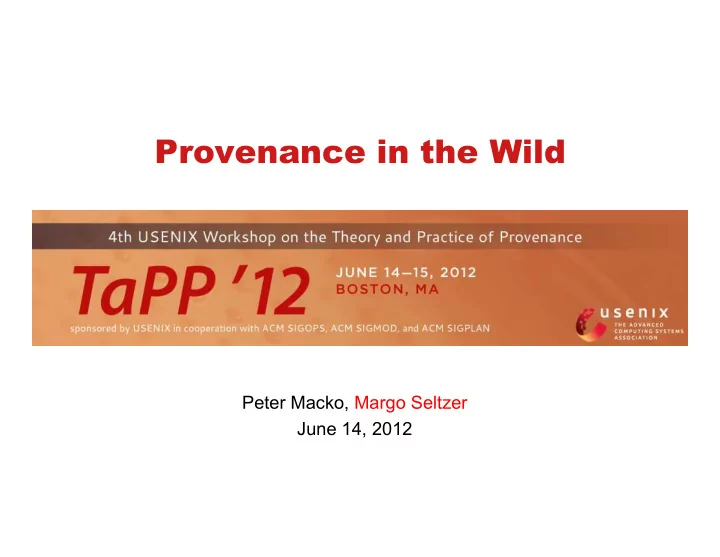

Provenance in the Wild Peter Macko, Margo Seltzer June 14, 2012
What’s the Problem? • What does it mean to collect provenance when you don’t control: – The data (types, format, organization, structure) – The operators – The environment in which its processed • Can you impose/ extract any semantic meaning to provenance when it’s collected by a herd of cats? http://www.newsrealblog.com/wp-content/uploads/2011/04/Herding-Cats.jpg June 2011 2
What do the Cats do? • They use data in arbitrary formats – Flat files – Unstructured, semi-structured, badly-structured – Proprietary formats – The cram twelve different kinds of data into a single container. • Transformations are arbitrary code – Pick your favorite turing-complete language. – Apply said language to data. – Transformations can depend on the environment. – Repeat • They move data around – Download objects from the web – Copy, rename objects – Replace objects • They install new software – New programs – New libraries – New compilers June 2011 3
A Proposed Architecture Applications Cmd line In multiple languages Language Python Perl R Java C adapters Provenance Library C++ Database DB adapter DB adapter DB adapter ODBC driver DB adapter adapters Provenance Store With multiple implementations Hbase Riak BDB MySQL SPARQL/RDF PostgreSQL adapter June 2011 4 4store
Why do we think this is a good idea? • Heterogeneous environments are the norm. • Provenance must span those environments. • Users and/or applications can: – create connections that are implicit or unobservable by software systems. – Integrate both static and dynamic dependencies. Bring provenance to the users rather than the users to the provenance. June 2012 5
Basic Use Model • Connect to the library: cpl_attach � • Disclose provenance – Create/lookup objects: cpl_create_object, cpl_lookup_object � – Disclose data flow: cpl_data_flow � – Disclose control flow: cpl_control_flow � – Add properties to objects: cpl_add_property � • Disconnect from the library: cpl_detach � June 2012 6
Naming • Goal is to allow interoperability with minimal coordination. • Objects are identified by three parameters: – Namespace: the application or system component that “owns” the object. Examples: OS, a specific database, workflow engine or application, or a project. – Name: local name (unique within a namespace) – Type: file, process, or namespace-specific type – Version: cycle avoidance algorithm create versions June 2012 7
Additional Automatic Capture • Capture object creation MAC address so that we can transmit provenance across a network (and still identify it). • Capture provenance of provenance – Ties provenance to a specific instance of an application (e.g., a process). – Results in capture of command line arguments (e.g., size of the Java heap). June 2012 8
Use Case: GraphDB Bench • A benchmark suite (and lots of experiments) to evaluate absolute and relative performance of graph databases. • Instrument flow from the graph database to the benchmark operators to results. • Modifications: 270 lines of code (out of 7500 total) – Most is cut and paste • Result: every csv result file has provenance indicating which operations were run, what the source database was, etc. • Helped us debug benchmark suite, identify missing benchmark results, etc. • Integration with scripts led us to develop command-line tool to track directory creation, file copies, etc. June 2012 9
Discussion • Won’t this free for all lead to semantically meaningless provenance? – Some provenance is better than no provenance. – Users/application developers who care are likely to provide more semantically meaningful provenance than is available by less flexible systems. • What do you do about missing provenance? – Some provenance is better than no provenance. – “Downstream” applications can connect upstream to bypass provenance oblivious applications. • Bottom line: We make rope – make it possible to have provenance without requiring that analysts or programmers use specific languages or tools. June 2012 10
Recommend
More recommend